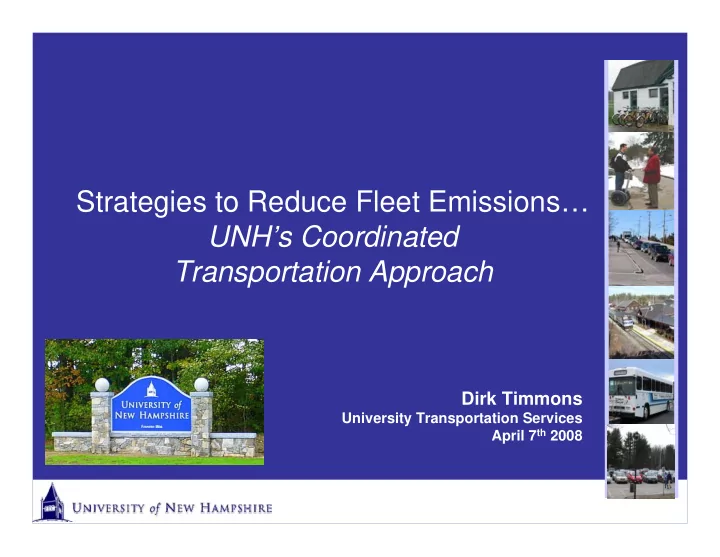

Strategies to Reduce Fleet Emissions… UNH’s Coordinated Transportation Approach Dirk Timmons University Transportation Services April 7 th 2008
Campus Image There are three distinct and differentiating images: New England village New England college New England landscape
Systems Approach Sustainability � Climate Education � Transportation Systems • • After heat and electricity, fleet fuel consumption and personal commuting are the biggest energy uses and emission generators at UNH. • Eco-Line™ deals with first two items….Today, an overview of our transportation and alternative fuel efforts • We are approaching the issue with a series of institutional practices, transportation system choices, demonstration of new technologies and general community education
Evolving Transportation Policy Leadership and Community Dialog • 2001 Transportation Demand Management Policy – dialog on transportation choices, costs and impacts on land-use, climate and energy • 2004 Campus Master Plan - reinforces walking campus • System Improvements Yield Positive Results : – Transit � 100% since 2001 - >1.1 million trips last year – Amtrak Downeaster � 500% - >50,000 this year – 2004-2006 UNH fleet fuel consumption : • Gas and petroleum diesel � 10% • CNG � 10x displacing >12,000 gallons gas/diesel • Biodiesel (B20) introduced 2006 - saved 11,000 gallons petroleum diesel • Increasing hybrid and electric vehicles in our fleet (demonstration of EVs) – Parking Permits - flat or down in last years – Ongoing improvements to short-term access, campus transit standards
20 Year Master Plan Context Reducing Commute trips (VMT) and emissions through on-Campus Housing 2002 2012 Build 2022 Build Population Component Base Projection Projection Faculty/Staff (all commute ) 3,320 3,400 3,520 Graduate (all commute) 2,150 2,325 2,500 Undergraduate Population: 10,850 11,450 12,000 On-Campus undergraduate housing 5,610 6,400 7,200 On-Campus family/graduate housing 333 420 566 Commute population 10,377 10,355 10,254 Faculty/Staff plus students minus on-campus housing Reduced traffic and emissions due to significant increases in on-campus housing
Coordinated Efforts Energy-Transportation – Climate Education • UNH Clean Fleet Programs – Eco-Cat alternative fuel – B20 Biodiesel transition – CNG for on-campus – Enterprise hybrid fleet – Right-sizing and AFV use • DOT/DOE/EPA Partnerships on high visibility successful projects – Over $6.5 million of USDOT and USDOE funds leveraged for transit, rail station, ped/bike and alternative fuel projects • Investment in Transit – Leveraged USDOT funds – Voluntary student investment – Expanded free community transit – Cost-effective utilizing student drivers – Largest transit agency in state • Projected 1 million trips removing over 4 million VMT in 06-07
Institutionalizing Choices: Clean Fleet Practices and Policies Vehicle Need Identified by User (replacement or new) Determine ‘ Right Size ’ for Customer Need Screen for Alternative Fuel suitability potential grant funding by Energy Staff Provide Fuel Efficiency Thresholds and Life Cycle Cost review s = purchasing options in an approved vehicle list Client Selects eligible vehicle. At registration, vehicle stats recorded with BSC (fuel type, Epact, grant, tax credit)
Fleet Fuel Consumption and Emissions UNH - Durham Fleet Fuel Consumption FY 2004-2006 Plant & Non- Non- UNH Total UNH Transit Transit Animal Transit Transit Gallons Total Gallons CNG Sciences Gallons CNG Diesel/B20 CNG Diesel/Gas therms Gallons Diesel/Gas therms /Gas Therms TOTAL Diesel/Gas 2004 91,961 387 15,687 118,463 787 210,424 1,174 211,598 2005 81,981 15,548 14,292 106,336 3,887 188,317 19,435 207,752 2006 1 222,000 83,600 15,145 16,700 120,000 3,786 220,300 18,931 Change 04-06 -9% +40X +6% +1% +5X +5% +10x +5%% 2007 data will show B20 transition
Fuel Efficiency Next Steps • Fulfill Mandates and meet/exceed State/Fed and UNH Goals – Governor’s Executive Order re Fuel Efficiency and EPAct • Demonstrate leadership as part of Climate Education Initiative • Formalize Vehicle Choice Policies incorporating life-cycle and emissions • Utilize selection/analysis procedures from EPA Smart Way programs • Improve benchmarking and fleet mgmt • Continue Clean Fleet & Eco-Cat. • Continue AFV infrastructure research, support and investment and public demonstration
Transportation Improvements Underway New Transit Fleet – Ongoing $1.5 million of new clean fuel vehicles since 05 Main Street-East (2007) $1.9 million street redesign improved bike/transit Rail Station (2007) $913,000 renovation and transit improvements CNG Station/Garage Upgrade (2007-8) $900,000 renovation and transit improvements Main Street-West (summer 09) $350,000 multi-use trail/sidewalk to west edge Next Steps? - McDaniel Drive Extension to Main St. - Conant Courtyard - Parking Consolidation - College Way
Recommend
More recommend